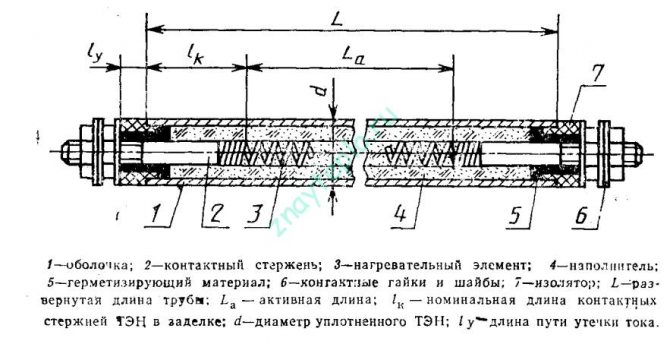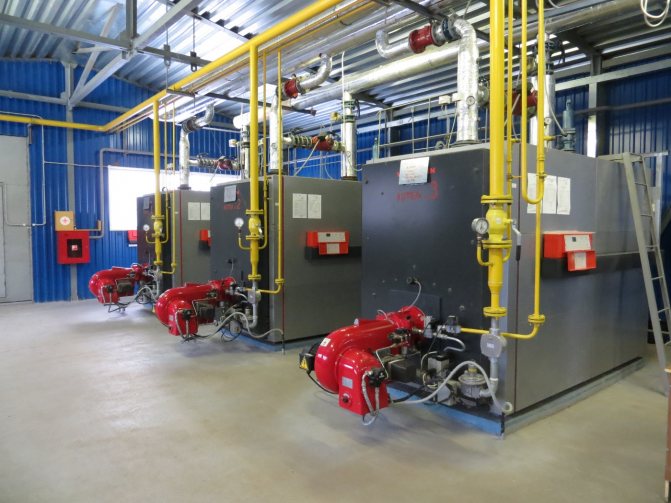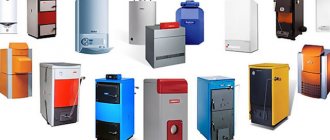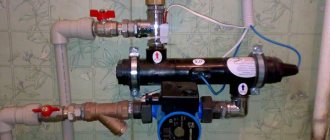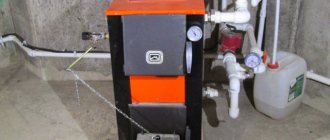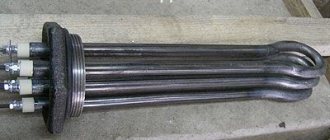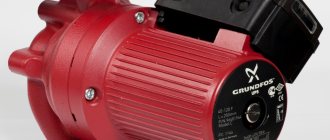Heating in the house can be converted to electricity. This transition is justified primarily by the availability of electricity, a high level of automation and a number of simplifications that will affect the design of the heating system. Comparing with gas or solid fuel options, an electric heating boiler with a pump greatly facilitates the operation process. The apartment eliminates the inconstancy of centralized heating and does not require permits. Not subject to prohibitions. For a private home, this is an opportunity to increase comfort without unnecessary hassle.
An electric boiler is strikingly different from its counterparts, which run on gas, wood, coal or even wasteful diesel fuel, but the principle of operation remains the same. There is a reservoir in which the coolant is heated by means of electric heating elements, from one to three. Water enters the heating system through pipes and circulates under the influence of a pump.
Elements of an electric heating boiler:
- water tank;
- electrical heating elements;
- circulation pump;
- starting relay, thermal relay;
- flow sensor;
- air pressure relief valve;
- water pressure relief valve;
- expansion tank (optional);
- control controller (optional);
Device diagram
Heating elements can be:
- electric heating elements;
- induction heaters.
There are practically no differences for the user between them. Induction heaters, according to the manufacturer, have a longer service life and do not decrease in efficiency over time. However, in practice, to a greater extent, the durability of the boiler is due to the preparation of the coolant. Control of its composition in order to avoid silting or the appearance of salt build-up on the walls of the heating tank.
Most often, induction heaters are used in flow systems, boilers with a minimum volume of coolant in the internal tank.
The boilers are supplied with one or more heating elements. The control activates separately each heating element or all together, which makes it possible to regulate the boiler performance, and at the same time prolongs the life of the heating elements, activating them one by one.
Boilers with heating elements are additionally divided into:
- with storage capacity;
- flowing.
The presence of a volumetric reservoir allows increasing the heat capacity of the heating system. However, they are significantly heavier and are produced in floor-standing design. Flow-through structures are compact and are often mounted on the wall.
The main differences between an electric boiler:
- The small volume of the tank for heating the coolant, for a 3-5 kW boiler is only 1.5-3 liters. Reduction of the total volume of the heating medium in heating.
- The exact power value in accordance with the power supply used (single-phase or three-phase) and the power of the heating elements.
- Smooth regulation of the coolant temperature without surges.
- The boiler does not require the installation of a chimney or the obligatory arrangement of a separate room, only a convenient point of connection to the heating pipes and the supply of the supply network is needed.
The only mandatory requirement is the presence of a powerful electrical input to the apartment or house.
Boilers up to 12 kW can be powered from one phase (220V). For more powerful models and some boilers from 6 kW, a three-phase power supply (380V) will be required. In apartments, especially in old buildings, the input is too weak even for an average power boiler of 4.5-6 kW, and before installation you will have to attend to this issue.
The minimum set of automation is a start relay and a thermal sensor that determines the temperature of the coolant. By adjusting the temperature sensor and setting the level of its response, the maximum permissible temperature of the water in the system is controlled.
Devices with several sensors that measure the temperature of water at the inlet and outlet of the boiler, as well as with a control controller, a programmer, capable of remembering the set boiler operation mode with a weekly schedule, allow to adjust the operating mode more precisely.
Circulation pump
The presence of a circulation pump and an expansion tank in the boiler is a complete solution for heat supply. The pump constantly and evenly pumps the coolant through the pipes to the radiators and back to the boiler. In contrast to the old configuration with natural circulation, three main problems are solved:
- There is no need to increase the cross-section of the pipes and the volume of the system to reduce the hydrodynamic resistance, the diameter of the pipes is selected only to pump the required volume of the coolant without any problems.
- It is unnecessary to part the supply pipes strictly from the top, and the return pipes from the bottom. The optimal variant of two-pipe or one-pipe lower wiring is used. It becomes possible to hide pipes in a screed or sew them into walls.
- The time for the heating to reach the operating mode is reduced. Radiators warm up faster, as does indoor air.
The best option is a glandless pump. In it, the rotor is located directly in the fluid circulation channel. This solves the problem of heat dissipation generated by the pump motor.
The pump is included in boilers designed for heating apartments, cottages and small houses with a capacity of up to 12 kW. Designed primarily for one-pipe connection or two-pipe connection with a small number of branches.
If you plan to use a collector group, then it is preferable to use separate circulation pumps for each of the circuits separately.
Scheme of work
The principle of operation of an electric boiler is simple. Electricity is converted into heat in heating elements with high ohmic resistance. The coolant is heated from them or induction elements and is pumped through the system with the help of a pump. Due to the constant circulation, the water heats up evenly and quickly.
To start water into the system, a special inlet with a check valve and pressure protection is used. The optimum pressure for electric boilers and autonomous heating systems is set at 3 bar. It is monitored by a pressure sensor and displays a pressure gauge. It regulates the pressure of the expansion vessel, which can accommodate the excess volume of liquid formed during thermal expansion.
As soon as the water temperature reaches the required value, the thermostat is triggered and the power supply to the heating elements is turned off. As soon as the temperature value drops by a couple of degrees, the relay is triggered again, turning on the heating elements.
To remove air and gases, a special air valve is used, more often located next to the pump. A water pressure sensor should prevent a critical increase in pressure that can harm the heating elements. With an excessive increase in pressure, which the expansion tank cannot cope with, the liquid is discharged through the valve into the sewer.
Popular manufacturers of electric boilers

The TOP manufacturers of the best models of electric boilers include:
- Bosch - service life 15 years;
- Vaillant eloBlock - works without interruption for 10 years;
- Protherm - service life 10 years;
- Tenko Premium - 10 years;
- Leberg - 10 years old;
- Hi-Therm - 10 years old;
- Kospel is 15 years old.
The rating is based on a comprehensive analysis of the functions and equipment of the devices. The ability to work in a cascade with other heating systems is also taken into account, as well as the possibility of connecting the "warm floor" function.In some models, the basic equipment does not provide for the presence of a circulation pump, an expansion tank and a safety group. These devices will have to be purchased separately, which will affect the final cost of the equipment.
How much electricity consumes
With regard to electric heating boilers for a private house, the answer to this question is simple. The efficiency is high and reaches 96-98%. The heat does not go into the pipe, it is not divided between the ambient air and the coolant reservoir, the boiler is located directly in the heated room, and therefore any side heat release still does not go to waste.
The only significant waste of electricity is the operation of the pump and the control circuit, however, in comparison with the total consumption of heating elements, these costs are 0.5-1%. The rest of the losses are associated with the costs of expanding the liquid, overcoming the hydraulic resistance and losses in the supply wires.
The conclusion is simple - the consumption of an electric boiler is approximately equal to the power consumption. For a three-fuel flow-through design for 6 kW, the consumption can be 2, 4, 6 kW, depending on how many heating elements are currently involved. As a result, all the power will go to the heating radiators to heat the room.
There are differences in induction water heaters and flow-through boilers. There, the power consumption differs from the output by 5-10%, their efficiency is lower than that of heating elements. This is due to the physics of the process. Heating occurs under the influence of an electromagnetic field, and part of it is simply dispersed in space.
Choosing a boiler for different purposes


The boiler is chosen depending on the place and purposes of operation.
Electrical equipment for heating small spaces - garages, saunas, summer kitchens - can be quickly installed and connected. This is the advantage, since you do not need to go to the authorities and seek permission for a gas boiler.
Depending on the area of the room and the material of manufacture (wood, brick, sippanels), an electric boiler of the required power is selected, as well as the number of circuits and the method of connection suitable for other requirements.
Electric boiler for a bath
For a sauna built of wood and insulated with synthetic materials, a powerful boiler is not needed. It is enough to calculate according to the formula 1 kW / 10 square meters. If you need to quickly heat the room, choose an electrode or induction boiler. If the bathhouse is located next to the house, the heating element can be turned on in advance, since it takes longer to heat up.
Since utility rooms are rarely used, a domestic manufacturer's unit is quite suitable for a bath, on which you can save money.
Electric boiler for a private house
For a private house, saving on heating is inappropriate, since the device may fail at the most inopportune moment. It is known that foreign-made units have a longer service life than domestic ones, so they work without breakdowns, but with preventive maintenance and flushing the system every 2 years.
From the heating elements, you can choose the Evan boiler. From domestic - the Proterm Skat electric boiler, which can be connected to a single-phase network without additional modifications. The Evan electric boiler has a different modification with the ability to connect to a different electrical network.
Installation
The main criterion for installing an electric heating boiler is the presence of a powerful input in an apartment or house. Depending on the type of boiler, its power supply can be single-phase or three-phase. The instructions for the boiler indicate what its power consumption, current, and what cross-section should be the supply wires.
The cable cross-section is calculated depending on the current strength, while the final selection is made from a number of standard values, always rounded up.The input should naturally be even more powerful to power all other equipment in the house.
The power cable is laid in a groove or in a box in a protective corrugation, with a separate branch directly from the distribution board. Separate automatic devices for the boiler supply are installed accordingly.
It is better to install a suspended boiler closer to water pipes and sewers. A toilet, bathroom or kitchen is better suited for this than a corridor or any other room. It will be necessary to additionally connect the outputs of the emergency valves for water with the sewage drain, and the valve for replenishing the coolant with the water pipe.
It is better to hang the boiler on a solid supporting wall. For installation on a partition, it must be additionally reinforced. The weight of the structure is quite large, especially in the presence of an expansion tank.
Additionally, manufacturers stipulate minimum distances from all sides of the boiler from enclosing structures and other obstacles. This is necessary for access to functional parts and supply lines.
To connect the pipes, signed and marked branch pipes with the designation of the inlet and outlet are used. For models designed for installation in apartments and houses, the diameter is most often ¾ inch. The pipes are supplied at the bottom of the boiler. On some models, it is possible to correct the direction of the leads in order to optimize the routing routes.
As a full-fledged alternative to gas heating, today many consumers choose electric heating boilers with a pump responsible for the forced circulation of the coolant in the system. These devices have a number of quite tangible operational advantages, and therefore there is a steadily growing demand for this type of product on the market.
In our article, we will describe in detail the design of electric heaters with a circulation pump, as well as analyze the pros and cons of installing them.
Specifications
The technical characteristics of an electrical device include power, number of circuits, efficiency, connection method, material for manufacturing parts and housing, as well as the type of automation and dimensions of the device.
Unit power


The power required to heat a room is roughly calculated: 1 kW per 10 square meters. But when choosing the power, other characteristics are also taken into account: wall thickness, ceiling height, heat loss due to an uninsulated ceiling or old wooden windows, the number of chambers in double-glazed windows on metal-plastic windows, the total area of windows in a house or apartment. You should also take into account the peculiarities of the climate in a particular region.
There is no exact formula to calculate how much electricity is consumed when the boiler is operating. Here you need to understand that electrical equipment consumes as much energy as it leaves the room during the cold season.
It is profitable to buy the equipment that has a representative office in the region in order to carry out high-quality repairs if necessary. Domestic electric boilers are made with high quality and are cheaper, but in a certain region there may not be a master familiar with the design of the models.
On boilers, the type of power regulation may differ - smooth or step. If the unit has additional heating capacity, the type of regulation will be stepwise. Usually the main element provides half of the total power, the other two provide 25% each. If necessary, you can disable additional elements.
Efficiency of electric boilers
It is useless to choose an electric boiler for efficiency, since all models have a high rate - from 96 to 98%. Energy conversion, not its generation, is the principle of all heating equipment of this type.
Number of contours
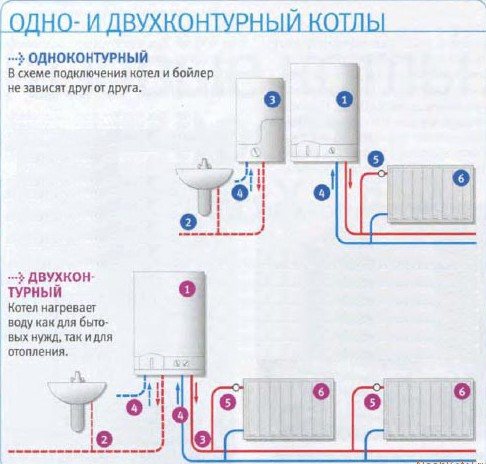

If the boiler has one circuit, it will only work to heat the room. In this case, it is recommended to take care of the method of heating the water.Double-circuit equipment is capable of switching from space heating to water heating for users.
Connection method
You can choose a single-phase or three-phase boiler - 220 and 380V, respectively. Depends on what type of electrical wiring is available in the house. The power of a single-phase unit will be less, more than a three-phase unit.
Materials (edit)
It is important for the service life of what materials the internal parts and the body are made of. The metal frame is capable of withstanding shock loading, so it is more profitable to buy it. Basically, all manufacturers produce boilers in a metal case.
Automation type


In electric boilers, one of two types of automation is installed to control the air temperature in a room: electronic or mechanical. In the first case, the circuit is opened when the temperature reaches the desired level. The second has a remote sensor that controls the temperature. When it is reached, the device transmits a signal to the control unit, which turns off the unit.
When the temperature drops to a certain level, the equipment turns on again without human intervention. If you set the lower and upper temperature thresholds in the minimum range, the boiler will turn on and off more often. This affects the period of its operation in the case of a heating element boiler.
Equipment
There is a basic complete set of electric boilers and additional options. The second option is more expensive, but it may turn out that the subsequent installation of options will lead to an increase in the cost of the device several times, including the work of the wizard. Additional options include:
- drainage of water in automatic mode if the equipment is not used at low temperatures;
- control of pressure in the system;
- centrifugal pump to enhance fluid circulation through pipes;
- filter for water purification;
- remote sensor for temperature control in distant rooms.
Sometimes it is necessary to use an expansion tank, so it is bought separately, since it is not included in the basic package of the device.
Electric boiler with circulation pump
Design features
The design of devices of this type is not complicated.
By and large, their only feature is the presence of a pumping unit.
- The basis of the design is a heat exchanger, consisting of a container, inside which a heating device is located.
- A heating element (tubular electric heater) most often acts as a heating element, however, recently, electrode-type heaters have also been equipped with pumps to ensure the continuous movement of heated water through pipes.
- In addition to these parts, the kit includes (responsible for the temporary storage of the coolant before it is launched into the pipeline system), a valve that protects against the reverse movement of water, as well as a filter that is responsible for water purification.
- This design works under the control of an electronic unit that regulates the temperature mode of the heater operation, as well as turning on and off the device.
- An integral part of the entire system is the circulation pump for the heating boiler. The main function of this device is to maintain a constant speed of movement of water through the pipes, while ensuring the most efficient heat exchange and heating of the room.
All components are mounted inside the casing with heat-insulating protection, which reliably protects the boiler from unnecessary heat loss. Due to this, the energy efficiency of the heating system is significantly increased and the consumption of energy carriers is reduced.
Selection criteria
By what criteria will we choose a device for installation in the heating system?
For electric boilers with a pump, these criteria are:
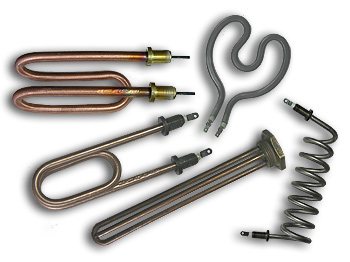

- Power
... It is provided due to the operation of heating elements installed in the heat exchanger.This parameter is indicated in kW, and when we talk about the power of the boiler, we mean exactly the characteristics of the heating elements. As a rule, there are models on the market with a capacity from 2-3 to 60-70 kW.
Note! Low-power devices are most often used for heating small private houses or summer cottages. Models with a power of 50 kW or more are intended for industrial use
- Heat storage tank volume
... The use of this element allows you to significantly increase the efficiency of the boiler, therefore you should not neglect its installation. The larger the volume of this container, the more efficient is the distribution of the coolant through the pipes. Experts recommend choosing a heat accumulator at the rate of at least 20 liters per 1 kW of heating element power. - Voltage
... For single-phase networks with a voltage of 220 Volts, it is allowed to install boilers with a power not exceeding 12 kW. If it is necessary to install a device with a higher performance, then a mandatory requirement will be the presence of a three-phase network (380 Volts) in the building. - Cable cross-section for connection
... The more powerful the heating unit, the thicker the electrical cable used to power the system must be. So, for boilers up to 4 kW, a cable with a cross-sectional area of 4 mm 2 will be enough, and for a 12 kW boiler with a single-phase connection, a 16 mm 2 cable will be required. A table showing the dependence of the minimum cross section on power is given below.
Power calculation
As we noted above, the most important parameter for is its power. It must provide compensation for all heat losses of the heating system, as well as guarantee an uninterrupted supply of hot water to the building.
As a rule, when choosing an installation for heating a house, a complete heat engineering calculation is performed, which takes into account not only the area of the heated rooms, but also the condition of the walls, floor and ceiling, the quality of insulation, installed window and door structures, etc.
But if you plan to heat a private house, then you can calculate the performance according to a simplified scheme. Below is an instruction, following which we can independently find out the minimum required parameters of the device.
The formula for the calculation is as follows:
W = S x W beats / 10m 2, where:
- W is the required heating power (kW).
- S is the total area of all heated rooms (m 2).
- W beats - specific power per 10 square meters.
W ud is different for different regions of our country. In cold regions, this indicator ranges from 1.2 to 2, in central Russia, W beats are taken as 1, and for the southern part, values of 0.7 - 0.8 are used.
Boiler installation
In most cases, the installation of heating systems is carried out with the participation of professional craftsmen with special permits.
Despite this, it is still worth studying the sequence of installation work - at least in order to be able to control the quality of the implementation of each stage.
- The main difficulty when connecting an electric heating installation is to provide it with the required power. If your intra-house network provides this power, it is good, but if not, then you will have to contact the power grid for connecting an additional line.
- When this issue is resolved, it is necessary to install a meter, an electrical panel and a residual current device (at least 25 A).
- We install the boiler itself or hang it on the wall (as a rule, fasteners are supplied in the kit), after which we draw a cable of the appropriate section from the meter to it.
- Separately, we supply wires from temperature sensors to the boiler, which automatically regulate the switching on and off of heating elements.
- If you plan to use a reservoir for heat storage, we install them in separate sanitary cabinets.
- If the circulation pump is not included in the housing of the device itself, then the pumps for heating boilers are connected separately. In this case, a wire must be provided to provide power to the pump motor.
All elements are interconnected using pipes (metal or metal-plastic). After a test run of the system, there should be no undercutting of the coolant anywhere.
As you can see, the work is going to be quite difficult, so you should still carefully study the video instructions and documentation for your pump. The time that you spend on acquiring new knowledge will definitely pay off during the installation!
Selection and installation
When purchasing an electric boiler with a pump, you need to select the appropriate device parameters:
- Power - this parameter describes the power of the heating elements in the heat exchanger, it can range from 2 to 70 kW. Boilers with a capacity of more than 50 kW are used in industrial production.
- Volume - the capacity of the heat storage tank, the most optimal option: from 20 liters per 1 kW of heating element power.
The formula for calculating the power of an electric boiler
W = S * Wy / 10 m²
W - heating power (kW). S - area of all heated rooms (m2). Wy - power density per 10 m².
Thus, choosing the best option and correctly installing it, high-quality heating will be provided in your house.
It is not difficult to install and connect an electric boiler with a pump with your own hands. The main rule is compliance with all the requirements prescribed by the instructions.
If this is a wall-mounted unit, then first you need to fix the brackets on the wall, and then hang the boiler on them. The next step is to connect the heating circuits. Cut-off valves must be installed on the inlet and outlet pipes, they will be needed in case of repair or replacement of the boiler. After all the performed manipulations, the unit is connected to the electrical supply network.
Electric boilers are heating elements, electrode and induction.
Advantages and disadvantages
Advantages of operating boilers with a circulation pump
The growing popularity of this equipment is due to the quite obvious advantages provided by the use of electric heating systems in heating private houses:
- A wide range of models in terms of power allows you to choose exactly the brand that suits your conditions. Regardless of what you need to heat - a country house or an industrial workshop - you always have the opportunity to purchase an installation with suitable parameters.
- The economic effect of using electric heating systems is also quite obvious. The energy efficiency of modern models is very high (the efficiency is 97-99%), therefore the installation of such a boiler opens up opportunities for very significant savings.
- The use of a circulation pump integrated into the design itself also contributes to increased efficiency. Possessing a fairly low energy consumption, the pump contributes to the fastest possible passage of the coolant through all circuits, ensuring rapid heating of the air in the premises.
- Since during the operation of such a heating system, combustion products are not formed, it can be considered absolutely environmentally friendly. An additional plus is that there is no need to spend money on the construction of a chimney, as well as to ensure an enhanced air flow.
Note! Despite the absence of combustion products during the operation of the boiler, high-quality ventilation of the room in which it is installed is still necessary!
- The management of such devices is optimized as much as possible. Thanks to this, even a layman can control the temperature regime of the room.In addition, most of the models on the market have components that automate the operation of the heating element in the control unit, so adjustment is extremely rare.
In addition to these advantages, it should also be mentioned that the boiler of this design can be used as a source of hot water. At the same time, to optimize the water supply system, it is necessary to install an expansion boiler with a tank with a capacity of at least 80 liters.
Disadvantages and features requiring special attention
Despite the impressive list of advantages that an electric boiler with a built-in pump provides to its owner, this design also has quite obvious disadvantages:
- First, the cost of operating such a plant directly depends on the cost of electricity. For this reason, in most countries, electric heating systems are recognized as less efficient than gas or solid fuel boilers.
Advice! To reduce financial costs, experts recommend installing heat storage tanks. This allows you to reduce heat loss and reduce energy consumption for water heating.
- Secondly, the operation of the boiler itself and the circulation pump built into it depend on the presence of voltage in the network. Therefore, you should take into account the peculiarities of your region: if power outages are common for you, then it is better to opt for a different design of the heating system.
- Also, a way out of the situation can be the installation of an alternative heat source in case of an "emergency" situation, for example, a solid fuel stove or fireplace. Of course, they will not provide full heating, but in case of failure of the main system, they will protect the house from cooling down.
- It should also be taken into account that efficient operation of the "heater + pump" system is impossible without high-quality electrical wiring. That is why, when installing such heating with your own hands, you may have to completely change all the wires. This can also lead to additional costs.
As for such a parameter as the price of the device itself, here the total amount largely depends on the model you choose (and by and large - on the power needed to heat your home). You can find quite inexpensive boilers, but a really powerful device, by definition, cannot be cheap.
Electric heating systems with integrated circulation pumps, shown in the photo in our article, will provide efficient heating in your home. And although these devices are not without drawbacks, but, nevertheless, in some cases the choice of such boilers will be not only justified, but also the only correct one!
Electric boilers with a pump are used as an efficient, environmentally friendly source of heat and are suitable for heating any premises: from residential buildings and apartments to public institutions and industrial enterprises. The devices are equipped with a pump that performs the function of regulation and forced circulation of the medium in the system.
How to choose the right heating boiler?
It is recommended, after determining the heating system in the country, to choose the right heating boiler. This is an important point, since exactly comfort in the country will depend on the parameters of the heating equipment in cold weather, the efficiency of the system elements, the return of the selected heating energy scheme (efficiency).
Regardless of the heating equipment chosen, according to the type of fuel used, experts recommend taking into account the following in order to obtain thermal energy:
- What is the rated power required to heat all the premises of the cottage. This parameter can be calculated based on the data: the total heated area of all rooms or on the volume of the coolant required to warm up the rooms.
- Experts recommend taking the power of the boiler from a ratio of 1 kW to heat 15 liters of coolant. It is important to take into account the thermal insulation properties of the bearing walls of the cottage.
- The presence of a second circuit, which is used to supply the dacha with hot water and create a comfortable stay.
- Overall parameters of the heating boiler, what special requirements are there for the room in which it will be installed (solid fuel, gas boiler). Solid fuel flow heating boilers require a separate room (boiler room), and take into account the norms of DBN V.2.5-20-200. If the dacha is small, then in the kitchen you can install a gas or electric boiler up to 200 kW of power.
- The presence of external pressure and temperature control systems allows automatic regulation of water heating. In this case, the energy carrier is consumed optimally, the climatic zone and street temperature are taken into account.
- It is advisable to choose a model with a flow pump in the heater body.
Despite the high saturation of proposals, manufacturers of heating equipment in Russia produce noteworthy types of instantaneous heating boilers: Evan and Romstar.
Advantages of electric boilers with a pump
- Efficiency. Electric heating boilers with a pump are highly energy efficient. The efficiency of electric boilers is up to 97-99%. The pump increases the speed of movement of the coolant along the contours of the system and ensures the fastest possible warming up of the room.
- Saving. Boilers with a pump are characterized by low energy consumption, which can significantly save money spent on heating.
- Convenient management. The design of the products is optimized as much as possible, so everyone can cope with the control. Automated elements and thermostats included in the structure of the boiler control unit will provide the most comfortable control of the device.
- Environmental friendliness. When using electric boilers for heating with a pump, no harmful combustion products are formed, therefore, the device is environmentally friendly for human health. At the same time, there is no need for a chimney or additional installations to increase the air flow.
Types of flow heating
One of the most important steps in choosing a heating scheme is its type. The movement of the coolant can be carried out by gravity (gravitational) or using pumping equipment (forced). This affects the operational and quality characteristics of the heating system of a house or apartment. Let's consider the features of each of these schemes.
Gravity heating
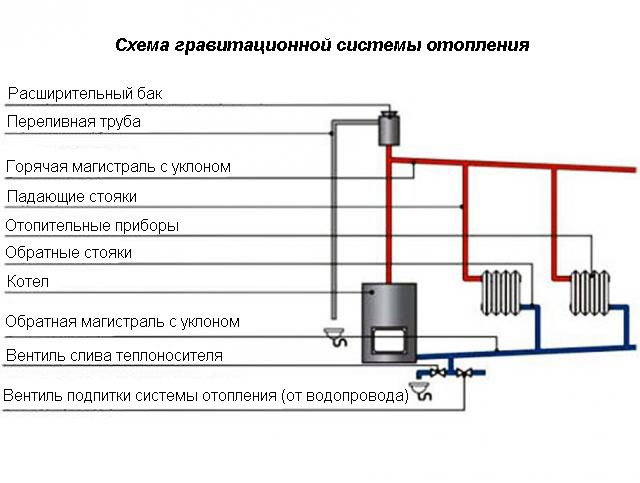

Gravity flow heating system
The simplest flow-through system is made gravitational. For its organization, flow-through heating boilers, an open-type expansion tank or a membrane one are needed. The transport line for the coolant is a pipeline that delivers water to the radiators and the boiler for reheating.
The main element is a flow-through boiler for heating. It must provide an optimal level of temperature conditions. It is from him that the rate of water circulation in the pipes will depend on it in the future. When the coolant is heated, it expands, as a result of which it begins to move along the highway. As it passes through the radiator pipes, the water temperature begins to drop. The cooled liquid flows through the return to the boiler for reheating.
The features of the gravitational flow-through heating system include the following:
- The short length of the pipeline - up to 30 m. This is due to the low circulating pressure;
- A flow-through electric boiler for heating is rarely used for this scheme. Most often, preference is given to solid fuel models;
- High degree of inertness.The speed of passage of hot water through the pipes directly depends on the parameters of the boiler, the presence of swivel nodes and branches in the circuit. Therefore, the heating of radiators in rooms farther from the boiler will be relatively slow.
Most often, the gravitational flow heating scheme is used for small houses or apartments. The positive qualities include its relatively low cost, as well as the ability to install a small flow heater for heating a house.
To create water circulation after leaving the boiler, a vertical riser is installed, the height of which should not exceed 5 meters. The heated liquid creates the required pressure for the further movement of the coolant.
Heating with forced circulation pumps
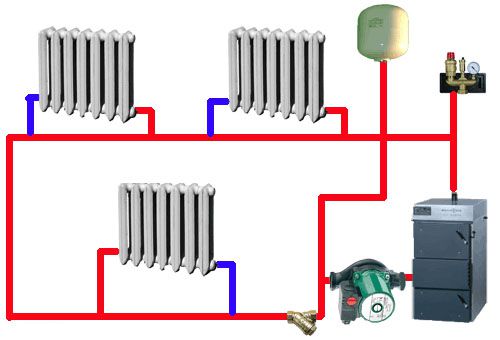

Flow-through forced heating system
To improve performance, a circulation pump is added to the flow-through heating system. This contributes to the fastest speed of water movement, which reduces the inertness indicator. Most often, an increased pressure of up to 3 atm is created in the line. As a result, the boiling point of the water rises and the likelihood of air pockets decreases.
If there is no main gas in the house or apartment, a flow-through electric heating boiler is most often installed. Their advantage lies in the possibility of choosing both single-circuit models (only for heating) and double-circuit (heating and hot water supply).
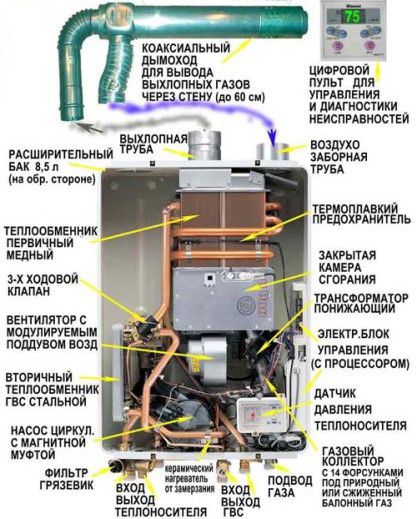

The design of a gas flow-through heating boiler
Since the forced circulation system in most cases is made of a closed type, it is necessary to provide for the installation of additional equipment. The main one is a sealed expansion tank installed on the return pipe in front of the heating boiler. Manometers and thermometers are also mounted. At the same time, the flow-through heating boiler must also have similar devices. The result is an effective system for maintaining a comfortable temperature in the house with the following distinctive characteristics:
- Low degree of inertia;
- Subject to the installation technology and the selection of components, a long, maintenance-free service life is ensured;
- The ability to create a temperature regime at the maximum level - 95/60 degrees;
- There is no need to install a booster riser, which is required for gravitational heating.
The disadvantages of forced circulation heating include increased requirements for pipes and radiators. They must withstand the maximum allowable pressure and the specified operating temperature. This scheme is applicable for houses with a large area of up to three floors.
When creating a scheme with forced circulation, it is recommended to purchase two-circuit electric flow-through heating boilers. Even if the house has a DHW system, you can use an additional one as a spare. The difference in cost between single-circuit and double-circuit models is small - about 10-15%.
How to choose an electric heating boiler with a pump
In the TeploExpert online store, various options for electric boilers with a pump are presented. When choosing a product, you should take into account the main criteria, which include:
- Power. The power indicator of the heating elements is measured in kW and is indicated in the technical data sheet for each product. For large industrial premises, boilers with a capacity of more than 50 kW are suitable.
- Contouring. The catalog contains single-circuit and double-circuit electric boilers with a pump. Devices with one circuit are only suitable for space heating. The double-circuit boiler additionally performs the function of hot water supply.
- Supply voltage. To install a boiler with a capacity not exceeding 12 kW in rooms with a single-phase electrical network, a standard voltage of 220 V is suitable.Higher energy efficiency products require a 380V three-phase network.
In our time of high technologies in the field of heating equipment, new technical solutions are constantly being introduced, aimed at improving the efficiency of work, safety and comfort during the operation of equipment. The result of one of these implementations is an electric boiler with a pump, built-in expansion tank and a circuit for providing hot water. In fact, a whole micro-boiler house is assembled within the framework of one high-tech product.
Application of heating boilers with an open chamber


The process of operating boilers that have an open combustion chamber necessarily involves the use of air that is located in the room where the equipment is installed.
Such wall-mounted water heating units have some structural features, which determines the peculiarity of their operation. This is the presence of elements such as:
• The combustion chamber. • Expansion tank. • Pump. • A system that is designed to remove the main combustion products. • Automation and security system.
What is a built-in pump for?
Electric heating boiler device with circulation pump
In electric boilers, there are no dimensional or massive elements that are an integral part of the design of other heat sources. Therefore, heating electrical installations are made, as a rule, in a wall-mounted version. At the same time, they are maximally completed with additional elements in order to simplify installation and piping of the boiler on site. One of the most important piping elements built into the heater design is a circulation pump. Its presence in an electric boiler is more than appropriate, especially if the latter provides a secondary circuit for hot water supply. Circulation pumps for boilers solve two problems:
- Forcing the coolant to flow through the pipelines of the heating system at a certain speed.
- In double-circuit electrical installations, they drive the coolant through a flow-through heat exchanger to prepare water for hot water supply.
In single-circuit boilers, the pump solves only the problem of forced circulation of water throughout the entire heating system. Here one nuance arises: the manufacturer supplies its product with a pump, the parameters of which approximately correspond to the power of the electrical installation - the average value of the hydraulic resistance, which the system of a given thermal power should have, is taken.
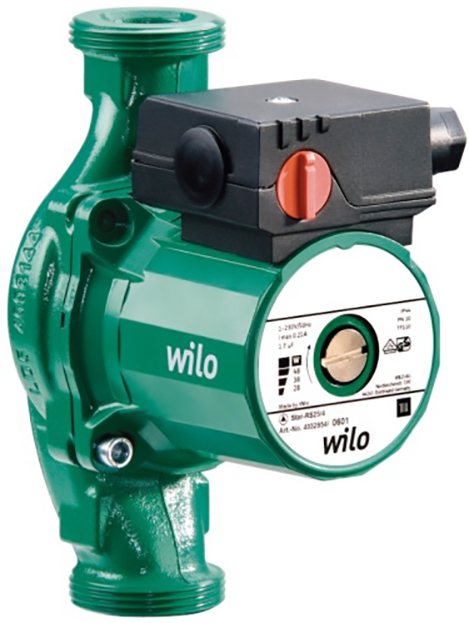

Wilo circulation pump for heating systems
But there are an infinite number of options for heating schemes, some of them have greater hydraulic resistance than a standard pumping device of a heat generator can overcome. Then an electric boiler with a pump will not be able to supply the coolant to all branches of the system.
A simple example: a standard pumping unit WILO-STAR-RS is able to provide a capacity of 6 m3 / h of heating medium, developing a pressure of 0.8 bar or 8 m wc. If the heat source is located in the basement of a three-storey cottage, then only to overcome the lifting height will require a pressure of about 0.6 bar. And you also need to deliver the coolant along the horizontal branches, the resistance of which is taken in aggregate according to this ratio: 10 m of the length of the horizontal pipe is considered as 1 m of the riser. And as a result of the calculation, it turns out that an electric boiler with a built-in circulation pump will not cope with its task, the circuit will not function.
Advice.
If we are talking about heating buildings with a branched system, long branches or large differences in height, then it is better to perform an enlarged calculation and check its result with the parameters of the pumping device, after consulting with a sales representative of the manufacturer of heat generators. This will save you from buying unnecessary equipment later.
A situation is possible when an electric boiler with a circulation pump has already been purchased, installed, and after that it turned out that the pressure of the standard blower is not enough. In this case, additional costs are inevitable, and the problem can be solved as follows:
- Make an enlarged calculation of the hydraulic resistance of the system independently or with the assistance of a specialist.
- According to the calculation results, purchase a separate circulation pump.
- Introduce a hydraulic separator (hydraulic arrow) into the circuit, then the heater blower will operate in a small circuit.
- Install a separate pump on a large heating circuit, as shown in the diagram:
Heating system with low loss header
Rules for the operation of hot water boilers
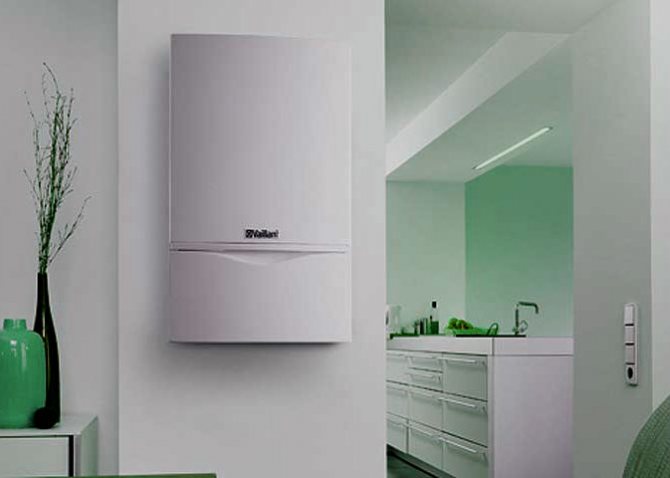

For the installation of heating systems, wall and floor boilers are used.
The latter are able to operate on any type of fuel. Before using the device, it is necessary to install it strictly on the floor surface, it is better if a separate room is allocated for this. The operating instructions for the hot water boilers must also be followed.
The equipment is equipped with all the required automation, therefore the operation process is simple. During operation of the device, the presence of a person may be required only to make certain temperature changes, as well as if it is necessary to turn off the equipment in the event of an emergency.
The steam boiler MZK is designed to produce saturated steam with a temperature of 175 ° C and a working pressure of 0.8 MPa used for technological and heating needs.
You can find out what a KP steam boiler is here.
Modern wall-mounted devices are mounted on the wall surface. Such equipment has compact dimensions, is easy to use, and does not require a separate room.
Without exception, all hot water boilers purchased from a trusted manufacturer have a fairly long service life, relatively simple and easy maintenance, economical and very quickly installed.
Circulation in double-circuit hot water boilers
The operation of double-circuit electric boilers with a pump is complicated by the need to periodically supply a heat exchanger with a coolant that heats water for hot water supply. Here, the blower alternately operates in the heating and hot water supply circuits, switching is carried out by a two-way valve with an electric drive at the command of the controller. This happens at the moment the hot water tap is opened in the house, this fact is recorded by the flow sensor and transmits a signal to the controller. After switching the flows, the circulation pump pumps the coolant into the flow-through heat exchanger until the tap in the house is closed and the two-way valve directs the flow into the heating supply pipeline. The device of a double-circuit boiler with a circulation pump is shown in the figure.
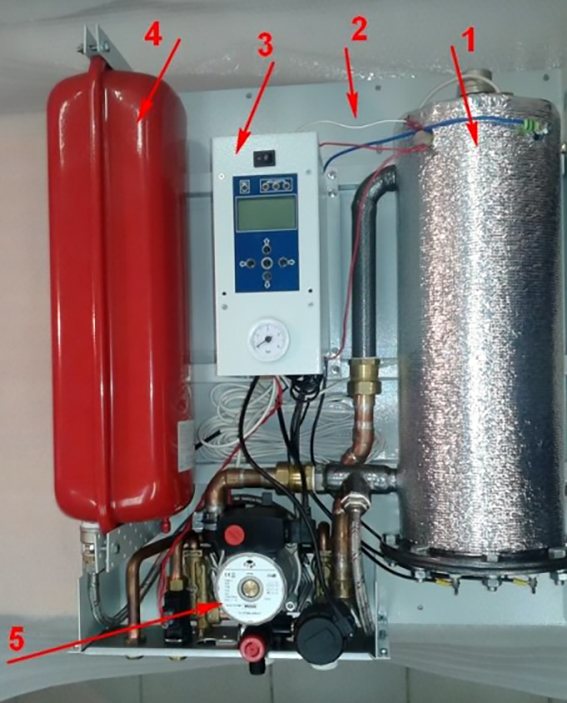

Installation diagram
1 - a flask with heating elements and an automatic air vent; 2 - unit body with mounting holes; 3 - controller; 4 - membrane expansion tank; 5 - pumping group with a two-way valve and a flow-through heat exchanger
.
The flow-through heater has rather narrow channels; accordingly, the blower is selected in such a way as to overcome the hydraulic resistance of the heat exchanger, taking into account its increase as scale appears.
For reference:
the automation of most electrical installations is programmed to periodically turn on the circulation pump in the summer, so that its rotor does not get stuck during idle time.
Installation and connection
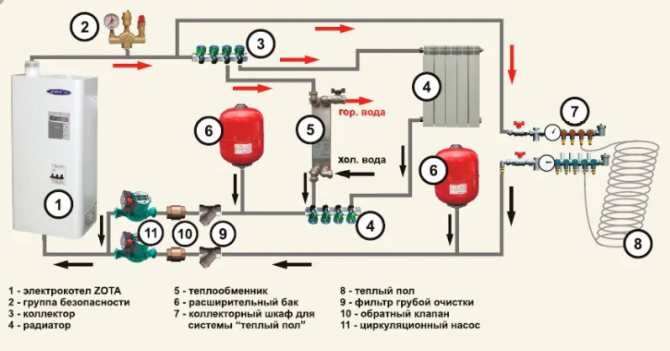

Electric boiler installation
There are no special rules for installing an electric boiler, but there are general points that must be followed:
- It is better to put the device in a separate room, where the younger family members cannot reach.
- Route the power cable so that no water gets on it. For this, plastic or metal boxes are used.For the same reason, the cable should not be laid under water pipes.
- The pipes are fixed to the wall so that their weight does not damage the body and parts of the boiler.
- The wire cross-section must correspond to the current strength, and the unit body must be connected to an earthing device.
To begin with, the body is attached to the wall with special canopies. The height above the floor level for the heating element boiler is at least 1.5 m. Other models can be installed lower. Usually, at the bottom of the boiler there is an inlet for cold or cooled liquid, and at the top, an outlet with hot water. The pipes are connected to the branch pipes using American taps.
An expansion tank and a sump for collecting debris or pieces of scale are mounted to the return flow line. There should be a faucet nearby to clean the sump.
For induction boilers, the installation is more complicated, since it is required to cut a circulation pump into the line, as well as a safety group: a pressure gauge, a safety valve and a device for bleeding air from the system. A mud collector and an expansion tank are also installed on the return line.
Particular attention is paid to the selection of the cable cross-section and the installation of the control unit for emergency shutdown of the device. The work is carried out according to the scheme specified in the technical passport of the boiler.
More about the selection of the boiler and its installation
The power of modern electric boilers varies in a wide range. On sale you can find both compact models, the power of which does not exceed 6 kW, and real "monsters", whose power is close to 100 kW. It is clear that such devices are used to heat large areas - they are not used in private construction.
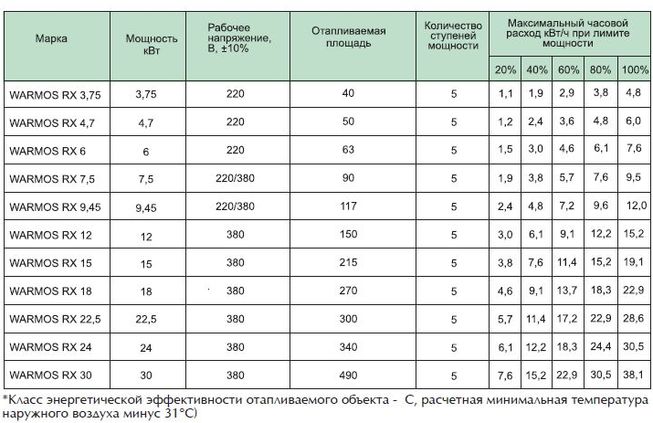

Characteristics of WARMOS boilers
Selection of boiler power
In the general case, the selection of the power of any boiler is carried out based on the heat loss of an apartment (or house), the climatic features of the area, the type of insulation, etc., are also taken into account in the calculation. the structures were balanced by the flow of thermal energy from heating radiators.
With a sufficient degree of accuracy, the required boiler power can be determined by an approximate relationship. Considering that all modern boilers are equipped with thermostats, a possible slight overestimation of power is not critical. And the price will not change much if you insure yourself and take a boiler a little more powerful than you received by calculation.
The required power is determined using such a relationship in the formula W_k = (S ∙ W_sp) / 10,
the following designations are adopted:
- Wк = boiler power, kW;
- S is the total heated area, m2;
- Wsp is the specific power, for warm regions it can be taken equal to 1.0, for central regions - 1.1 - 1.15, for northern regions - at least $ 1.2
- 10 - conversion factor.
If you use the proposed formula, then for heating a private house with an area of, for example, 160 m2, located in the central part of the Russian Federation, you will need a boiler with a capacity of W_k = (160 ∙ 1.1) / 10 = 17.6≈18 kW.
The result is quite close to the values recommended by the manufacturers themselves. So, for an area of 150 m2, a 19-kilowatt boiler is recommended, the calculation gave almost the same value.
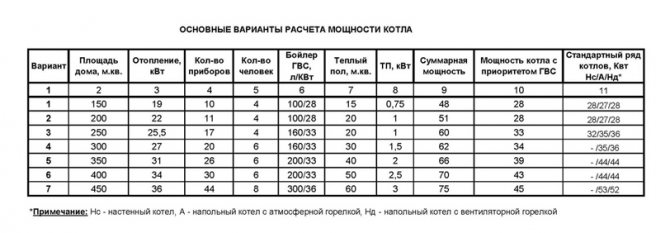

Recommended power values depending on the heated area
The simplest example is given - it is suitable for calculating the power of a single-circuit boiler. To select a double-circuit device, it is also necessary to take into account the energy consumption for heating water for the needs of hot water supply (hot water supply).
Wiring requirements
A rather serious obstacle to installing a boiler with your own hands can be the fact that you need to have at least minimal knowledge of electrical engineering. In particular, you need to understand that not every boiler can be connected to a regular power grid.
Note! The best option can be considered the laying of an individual power supply line for the boiler.If it is not technically possible to do this, then it is better to play it safe and not connect devices with a power higher than 6-7 kW to a regular network.
In general, the operating voltage of a 220V electric boiler is found only in relatively low-power devices. If a heating system for a private house is being designed, then, most likely, a boiler with a capacity of about 16-20 kW, or even more, will be used. This means that you will have to power it separately.
Note! Boilers with a power of more than 6 kW are equipped with a multi-stage power control system. During transition periods (autumn-winter, winter-spring), this allows you to reduce the cost of electricity for heating at times.
Neglecting the selection of the wiring cross-section will lead to heating of the cable. As a result, the insulation may melt and the possible consequences of such a development of events cannot be precisely called positive.
The instructions for selecting the wire diameter are quite simple. You can use an approximate dependence according to which a current of 1 A will require a wire cross-section with an area of 1 mm2.


Approximate ratio between power and cable conductor area
For example, you need to determine the minimum wire dimensions for connecting a 6 kW boiler, the connection is made to a regular 220 V.
in the formula, the designations are accepted:
- S = conductor cross-sectional area, mm2;
- U, I - voltage and current, respectively.
In the considered example, the cross-sectional area of the conductor should be S = 6000 / (8 ∙ 220) = 3.41 〖mm〗 ^ 2.
This approach is considered quite approximate. In addition, such a factor as, for example, the material of the conductor is not taken into account, and this also affects the maximum permissible current load. To select a cable for a more powerful boiler, it is still advisable to perform a more accurate calculation.
In this case, the calculation instructions will become a little more complicated:
- first you need to determine the current strength for each phase. The calculation is carried out according to the formula I = W_k / (U_l ∙ √3),
where Ul - line voltage, 380 V in our case;
- according to GOST 16442-80, the cross-section of the core is selected. In this case, it is necessary to take into account which metal is used - aluminum or copper, as well as the method of laying the cable - above- or underground.
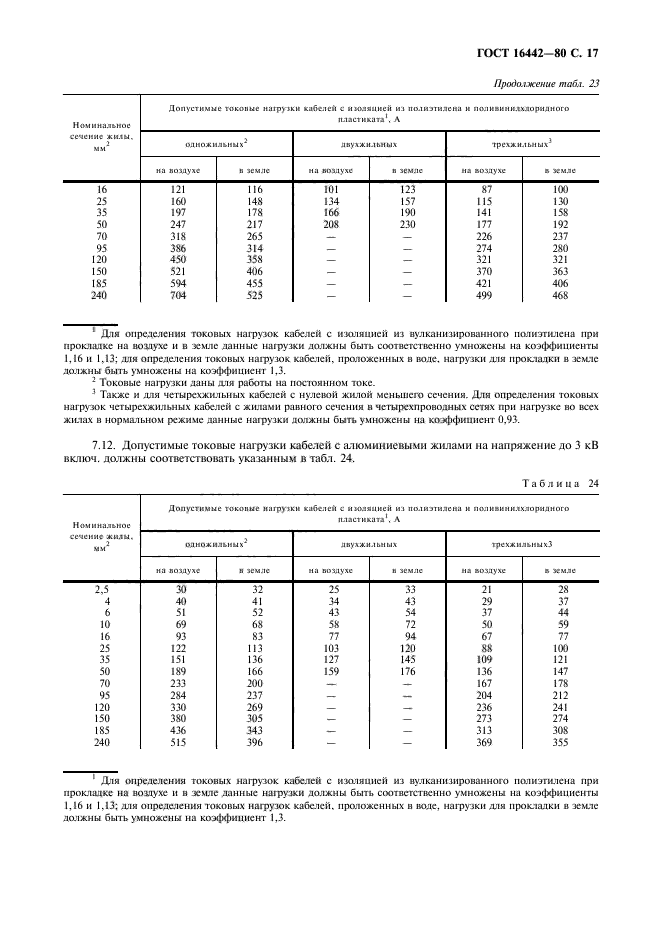

The values of the maximum currents depending on the cross-sectional area of the conductor
Let's consider an example of calculation for a 3-phase boiler with a power of 22 kW, the connection will be made using a 3-core cable.
The calculation is carried out according to the proposed method:
- we determine the current strength I = 22000 / (380 ∙ √3) = 33.43 A.
- according to GOST 16442-80, the cross-section of the core is selected, 2 options are possible. If copper is used, then a conductor with a cross section of 4 mm2 is quite suitable, for it the permissible current load will be 37 A, so that there will also be a small margin. For aluminum conductors, the cross-section of the conductor will have to be increased to 6 mm2 - the permissible current load in this case will also be 37 A.
The last thing left to do is choose a fuse of the correct rating. You can simply use the corresponding tables, in which the cross-sectional area of the core and the power of the automatic fuse are indicated for each value of the boiler power. For our example, a 35A machine is suitable.
Data for the selection of a fuse depending on the power of the boiler
Safety requirements
Electric heating boilers with a pump require special attention during the power supply phase.
Consider the following:
- the power of the automatic fuse should slightly exceed the maximum current during the operation of the boiler;
- grounding is mandatory when connecting. Grounding of the 3rd or 5th core in the cable is carried out;
- wire N (zero working) is connected to the terminal block of the shield (zero bus);
- grounding (PE wire in the diagram) is connected to the corresponding bus (marking "Ground").
Note! A common mistake when connecting is that people confuse N and PE wires. So at this point you need to pay special attention.
The photo shows the correct connection of the wires
